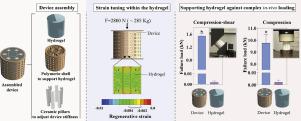Acta Biomaterialia ( IF 9.4 ) Pub Date : 2020-10-12 , DOI: 10.1016/j.actbio.2020.10.012 Ali Entezari , Michael V. Swain , J. Justin Gooding , Iman Roohani , Qing Li

|
Repair or regeneration of load-bearing bones has long been an incentive for the tissue engineering community to develop a plethora of synthetic bone scaffolds. Despite the key role of physical forces and the mechanical environment in bone regeneration, the mechanotransduction concept has rarely been incorporated in structural design of bone tissue scaffolds, particularly those made of bioactive materials such as hydrogels and bioceramics. Herein, we introduce a modular design strategy to fabricate a load bearing device that can support a wide range of hydrogel- and ceramic-based scaffolds against complex in-vivo loading conditions to induce desirable mechanical strains for bone regeneration within the scaffolds. The device is comprised of a fenestrated polymeric shell and ceramic structural pillars arranged in a sophisticated configuration to provide ample internal space for the scaffold, also enabling it to purposely regulate the levels of strains and stresses within the scaffolds. Utilizing this top-down design approach, we demonstrate that the failure load of alginate hydrogels increases 3200-fold in compression, 300-fold in shear and 75-fold in impact, achieving the values that enable them to withstand physiological loads in weight-bearing sites, while allowing generation of osteoinductive strains (i.e., 0.2-0.4%) in the hydrogel. This modular design approach opens a broad range of opportunities to utilize various bioactive but mechanically weak scaffolds for the treatment of load-bearing defects and exploiting mechanobiology strategies to improve bone regeneration.
中文翻译:

将机械转导概念整合到基于支架的骨组织工程中的模块化设计策略
长期以来,承重骨的修复或再生一直是组织工程界开发过多种合成骨支架的诱因。尽管物理力和机械环境在骨骼再生中起着关键作用,但是机械转导的概念很少被并入骨骼组织支架的结构设计中,特别是那些由生物活性材料(例如水凝胶和生物陶瓷)制成的支架。在本文中,我们介绍了一种模块化设计策略,以制造可支持多种水凝胶和陶瓷基支架抵御复杂的体内负荷的承重装置加载条件,以诱导支架内骨骼再生所需的机械应变。该装置由开孔的聚合物外壳和陶瓷结构的支柱组成,这些支柱以复杂的结构排列,可为支架提供充足的内部空间,还使其能够有目的地调节支架内的应变和应力水平。利用这种自上而下的设计方法,我们证明了藻酸盐水凝胶的破坏载荷在压缩时增加了3200倍,在剪切时增加了300倍,在冲击中增加了75倍,达到了使其能够承受负重的生理负荷的值。位置,同时允许在水凝胶中产生骨诱导性应变(即0.2-0.4%)。











































 京公网安备 11010802027423号
京公网安备 11010802027423号